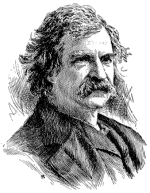The Boys’ Life of Mark Twain
by Paine

XLIV. A Reading-Tour With Cable
Every little while Mark Twain had a fever of play-writing, and it was about this time that he collaborated with W. D. Howells on a second Colonel Sellers play. It was a lively combination.
Once to the writer Howells said: “Clemens took one scene and I another. We had loads of fun about it. We cracked our sides laughing over it as we went along. We thought it mighty good, and I think to this day it was mighty good.”
But actors and managers did not agree with them. Raymond, who had played the original Sellers, declared that in this play the Colonel had not become merely a visionary, but a lunatic. The play was offered elsewhere, and finally Mark Twain produced it at his own expense. But perhaps the public agreed with Raymond, for the venture did not pay.
It was about a year after this (the winter of 1884-5) that Mark Twain went back to the lecture platform–or rather, he joined with George W. Cable in a reading-tour. Cable had been giving readings on his own account from his wonderful Creole stories, and had visited Mark Twain in Hartford. While there he had been taken down with the mumps, and it was during his convalescence that the plan for a combined reading-tour had been made. This was early in the year, and the tour was to begin in the autumn.
Cable, meantime, having quite recovered, conceived a plan to repay Mark Twain’s hospitality. It was to be an April-fool–a great complimentary joke. A few days before the first of the month he had a “private and confidential” circular letter printed, and mailed it to one hundred and fifty of Mark Twain’s friends and admirers in Boston, New York, and elsewhere, asking that they send the humorist a letter to arrive April 1, requesting his autograph. It would seem that each one receiving this letter must have responded to it, for on the morning of April 1st an immense pile of letters was unloaded on Mark Twain’s table. He did not know what to make of it, and Mrs. Clemens, who was party to the joke, slyly watched results. They were the most absurd requests for autographs ever written. He was fooled and mystified at first, then realizing the nature and magnitude of the joke, he entered into it fully-delighted, of course, for it was really a fine compliment. Some of the letters asked for autographs by the yard, some by the pound. Some commanded him to sit down and copy a few chapters from “The Innocents Abroad.” Others asked that his autograph be attached to a check. John Hay requested that he copy a hymn, a few hundred lines of Young’s “Night Thoughts,” etc., and added:
“I want my boy to form a taste for serious and elevated poetry, and
it will add considerable commercial value to have it in your
handwriting.”
Altogether, the reading of the letters gave Mark Twain a delightful day.
The platform tour of Clemens and Cable that fall was a success. They had good houses, and the work of these two favorites read by the authors of it made a fascinating program.
They continued their tour westward as far as Chicago and gave readings in Hannibal and Keokuk. Orion Clemens and his wife once more lived in Keokuk, and with them Jane Clemens, brisk and active for her eighty-one years. She had visited Hartford more than once and enjoyed “Sam’s fine house,” but she chose the West for home. Orion Clemens, honest, earnest, and industrious, had somehow missed success in life. The more prosperous brother, however, made an allowance ample for all. Mark Twain’s mother attended the Keokuk reading. Later, at home, when her children asked her if she could still dance (she had been a great dancer in her youth), she rose, and in spite of her fourscore, tripped as lightly as a girl. It was the last time that Mark Twain would see her in full health.
At Christmas-time Cable and Clemens took a fortnight’s holiday, and Clemens went home to Hartford. There a grand surprise awaited him. Mrs. Clemens had made an adaptation of “The Prince and the Pauper” for the stage, and his children, with those of the neighborhood, had learned the parts. A good stage had been set up in George Warner’s home, with a pretty drop-curtain and very good scenery indeed. Clemens arrived in the late afternoon, and felt an air of mystery in the house, but did not guess what it meant. By and by he was led across the grounds to George Warner’s home, into a large room, and placed in a seat directly fronting the stage. Then presently the curtain went up, the play began, and he knew. As he watched the little performers playing so eagerly the parts of his story, he was deeply moved and gratified.
It was only the beginning of “The Prince and the Pauper” production. The play was soon repeated, Clemens himself taking the part of Miles Hendon. In a “biography” of her father which Susy began a little later, she wrote:
“Papa had only three days to learn the part in, but still we were all
sure he could do it . . . . I was the prince, and Papa and I
rehearsed two or three times a day for the three days before the
appointed evening. Papa acted his part beautifully, and he added to
the scene, making it a good deal longer. He was inexpressibly
funny, with his great slouch hat and gait–oh, such a gait!”
Susy’s sister, Clara, took the part of Lady Jane Gray, while little Jean, aged four, in the part of a court official, sat at a small table and constantly signed state papers and death-warrants.
 Continue...
Continue...![[Buy at Amazon]](http://images.amazon.com/images/P/B0006AHKG6.01.MZZZZZZZ.jpg)